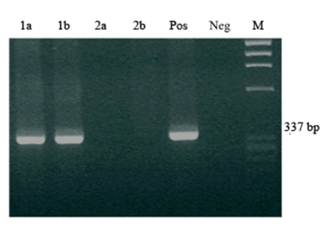First report of Neospora caninum abortion in a beef cow-calf herd

A female Brown Swiss fetus from a cow-calf herd from the Pyrenees Mountains in Andorra was submitted for diagnosis. A necropsy was performed and brain, liver and heart of the fetus were collected for diagnosis. The fetus had a multifocal necrotizing encephalitis and non-purulent multifocal myocarditis. The diagnosis was confirmed by demonstration of the presence of a 337 bp band corresponding to N. caninum (Fig. 1) and tachyzoites by specific staining with N. caninum polyclonal antibodies in the fetal brain.
The dam was 10-yr-old and part of a cow-calf herd composed of 65 animals. Two bulls for natural breeding and 2 dogs were associated with the herd. The herd grazed in communal areas at altitudes between 1,600 m and 2,300 m, together with a total of approximately 200 adult cattle from different local herds during the summer months. The herd was under the government health control program for quality meat of Andorra and was vaccinated following a strict vaccination program that included main abortifacients in cattle.
The dam of the aborted fetus had serum N. caninum antibodies at the time of abortion, but not 2 months before abortion took place. One year after the abortion, the animal was sampled again and was found to be seropositive. Neospora caninum antibodies were not observed in sera from the 2 dogs of the farm or from the 2 bulls used as natural breeders in the herd. The fact that the infected dam had been seronegative in previous serological analysis (the test performed only 2 months before the abortion) indicated that most probably the animal had become infected within a few weeks of abortion. Furthermore, the animal remained seropositive 1 year after the abortion. The breeder bulls in the herd were seronegative. Therefore, the ingestion of food or water contaminated with N. caninum oocysts eliminated by canids (besides the dogs in the farm, dogs walked by their owners, sled dogs in the winter (Figure 2) and red foxes are common in the areas that are grazed by cattle) appears a logical mode of infection. Based on the particular situation of Andorra, a case of abortion cause an economic loss of around 1,400 euros (around 1,700 US dollars) compared to a newborn calf that would have been kept on the farm, and around 950 euros (around 1,150 US dollars) compared to a born calf that would have been sent to a feedlot.
This is the first report of N. caninum abortion in Andorra and the first confirmed N. caninum abortion in an acutely-infected cow.
References
Ramon Armengol1, Marcela Pabón1, Carles Adelantado1, Fernando López-Gatius2, Sonia Almería1. "First report of Neospora caninum abortion in a beef cow-calf herd from Andorra, Europe". JOURNAL OF PARASITOLOGY, 92 (6): 1361-1362 DEC 2006.
1 Parasitologia, Departament Sanitat i Anatomia Animals; CReSA; Universitat Autònoma de Barcelona.
2 Departament Producció Animal. Universitat de Lleida.


